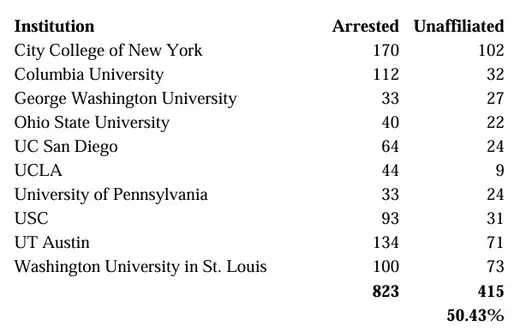On "Outside Agitators" and Gaza Protests
Below is a chart showing the numbers of people arrested during Gaza encampments and protests on a number of U.S. campuses.
Data was collected from The New York Times article titled “Where Protesters on U.S. Campuses Have Been Arrested or Detained,” and supplemented with additional numbers from local journalists, university papers and statements, and national news agencies. The arrest numbers are not an exhaustive list of total arrests related to Gaza encampments and protests. Rather, it is a sample from a group of institutions where there are reports on the affiliation status of those arrested.
More on:
So these numbers should be considered suggestive, not final or absolutely reliable. And what they suggest is that the protests were indeed seized upon by people unaffiliated with the universities and colleges in question, but determined to disrupt campus life in the service of their political goals. Only half of those "protesting" were students or faculty members.
This suggests other questions. Who were the 50.43% who were unaffiliated? Who financed their activities? Did the affiliated and unaffiliated act in the same ways, or was one group or the other more involved in violence, building takeovers, and extremist rhetoric as opposed to peaceful protest?
The involvement of such a percentage of persons unaffiliated with the universities presents special problems for administrators, because internal discipline such as suspension or expulsion will of course not be available when it comes to the unaffiliated. That may leave no alternative except arrests to bring the activities to an end. In real life, we've very often seen administrators threaten suspensions or expulsions and then back off, or even impose such penalties and then remove them as part of the price of getting protesters to disband. Faculty who violate university rules present a similar but even harder problem because they often have more protections, such as tenure.
My impression, now as the academic year is ending, is that punishment is extremely rare. Most charges have been or likely will be dropped, except perhaps in cases where "protesters" assaulted police. Academic penalties such as suspension appear to be disappearing as well. This sends a clear message: violations of the rules will be forgiven no matter how severe the violation if violators stick to their guns and threaten further disturbances. It is an invitation for more trouble, and quite an education for the vast majority of students who naively assumed rules were not made to be broken.
More on:
 Online Store
Online Store

